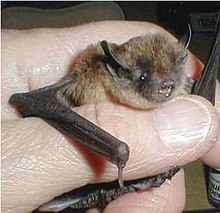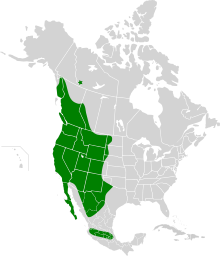
The big brown bat is a species of vesper bat distributed widely throughout North America, the Caribbean, and the northern portion of South America. It was first described as a species in 1796. Compared to other microbats, the big brown bat is relatively large, weighing 15–26 g (0.53–0.92 oz) and possessing a wingspan of 32.5–35 cm (12.8–13.8 in).

Natterer's bat is a European vespertilionid bat with pale wings. It has brown fur tending to greyish-white on its underside. It is found across most of the continent of Europe, parts of the Near East and North Africa. It feeds on insects and other invertebrates which it catches on the wing or pursues on the ground.

The serotine bat, also known as the common serotine bat, big brown bat, or silky bat, is a fairly large Eurasian bat with quite large ears. It has a wingspan of around 37 cm (15 in) and often hunts in woodland. It sometimes roosts in buildings, hanging upside down, in small groups or individually. The name serotine is derived from the Latin serotinus, which means 'evening', while the generic name derives from Greek ἔπιεν and οίκος, which means 'house flyer'.
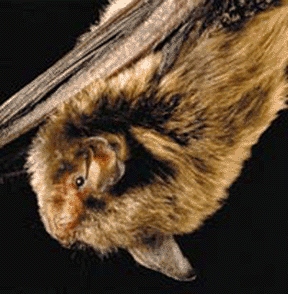
The Indiana bat is a medium-sized mouse-eared bat native to North America. It lives primarily in Southern and Midwestern U.S. states and is listed as an endangered species. The Indiana bat is grey, black, or chestnut in color and is 1.2–2.0 in long and weighs 4.5–9.5 g (0.16–0.34 oz). It is similar in appearance to the more common little brown bat, but is distinguished by its feet size, toe hair length, pink lips, and a keel on the calcar.

The pallid bat is a species of bat that ranges from western Canada to central Mexico. It is the sole species of its genus and is closely related to Van Gelder's bat, which is sometimes included in Antrozous. Although it has in the past been placed in its own subfamily (Antrozoinae) or even family (Antrozoidae), it is now considered part of the subfamily Vespertilioninae and the tribe Antrozoini.

The silver-tipped myotis is a species of mouse-eared bat found in a range of lowland habitats in the Americas.

The common noctule is a species of insectivorous bat common throughout Europe, Asia, and North Africa.

The greater mouse-eared bat is a European species of bat in the family Vespertilionidae.

Bechstein's bat is a species of vesper bat found in Europe and western Asia, living in extensive areas of woodland.

Brandt's bat or Brandt's myotis is a species of vesper bat in the family Vespertilionidae. It is native throughout most of Europe and parts of western Asia.

The western small-footed bat, also known as the western small-footed myotis, is a species of vesper bat native to North America.

The eastern small-footed bat is a species of vesper bat. It can be found in southern Ontario and Quebec in Canada and in mountainous portions of the eastern United States from New England to northern Georgia, and westward to northern Arkansas. It is among the smallest bats in eastern North America and is known for its small feet and black face-mask. Until recently, all North American small-footed Myotis were considered to be "Myotis leibii". The western population is now considered to be a separate species, Myotis ciliolabrum. The Eastern small-footed bat is rare throughout its range, although the species may be locally abundant where suitable habitat exists. Studies suggest white-nose syndrome has caused declines in their populations. However, most occurrences of this species have only been counted within the past decade or two and are not revisited regularly, making their population status difficult to assess. Additionally, most bat populations in the Eastern U.S. have been monitored using surveys conducted in caves and mines in the winter, but Eastern small-footed bats hibernate in places that make them unlikely to be encountered during these surveys. Perhaps as a result, the numbers of Eastern small-footed bats counted in winter tend to be low and they are relatively variable compared to other species of bats. Many biologists believe the species is stable, having declined little in recent times, but that it is vulnerable due to its relatively restricted geographic range and habitat needs.

The fringed myotis is a species of vesper bat that is found in British Columbia, Mexico, and the western United States.
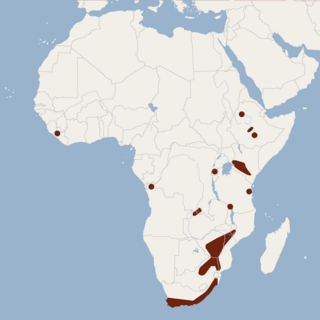
The Cape hairy bat, also known as little brown bat, Temminck's mouse-eared bat, Cape myotis, tricoloured mouse-eared bat, Cape hairy myotis, Temminck's hairy bat and three-coloured bat is a species of vesper bat that is found in Sub-Saharan Africa.
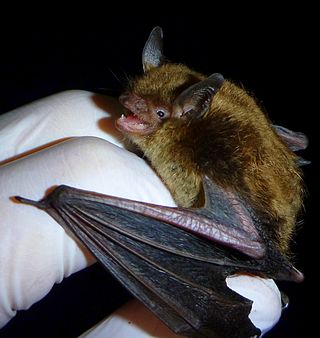
The little brown bat or little brown myotis is an endangered species of mouse-eared microbat found in North America. It has a small body size and glossy brown fur. It is similar in appearance to several other mouse-eared bats, including the Indiana bat, northern long-eared bat, and Arizona myotis, to which it is closely related. Despite its name, the little brown bat is not closely related to the big brown bat, which belongs to a different genus.

The Virginia big-eared bat is one of two endangered subspecies of the Townsend's big-eared bat. It is found in Virginia, West Virginia, North Carolina, and Kentucky. In 1979, the US Fish and Wildlife Service categorized this as an endangered species. There are about 20,000 left and most of them can be found in West Virginia. The Virginia big-eared bat is the state bat of Virginia.

Myotis septentrionalis, known as the northern long-eared bat or northern myotis, is a species of bat native to North America. There are no recognized subspecies. The northern long-eared bat is about 3–3.7 inches in length, with a wingspan of 9–10 inches. It is distinguishable by its long ears when comparing it to other bats in its genus. This species is commonly found in the northern United States and Southern Canada east of British Columbia. The geographic range includes 37 states.

The California myotis is a species of vesper bat. It is found in British Columbia in Canada, Guatemala, Mexico, and in the western United States, including California.
There are eighteen indigenous species of bats in Canada, which are found in many parts of the country. They are insectivores, and are prey to falcons, hawks, owls, snakes, cats, and raccoons.
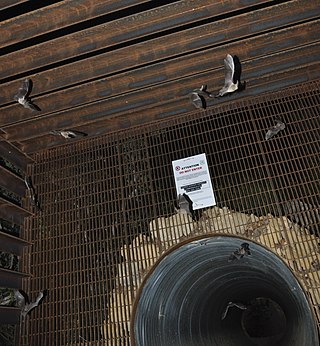
A maternity colony refers to a temporary association of reproductive female bats for giving birth to, nursing, and weaning their pups. The colonies are initiated by pregnant bats. After giving birth, the colony consists of the lactating females and their offspring. After weaning, juveniles will leave the maternity colony, and the colony itself will break apart. The size of a maternity colony is highly variable by species, with some species forming colonies consisting of ten or fewer individuals, while the largest maternity colony in the world in Bracken Cave is estimated to have over 15 million bats.
